Introduction: A Mirror to the Dutch Soul
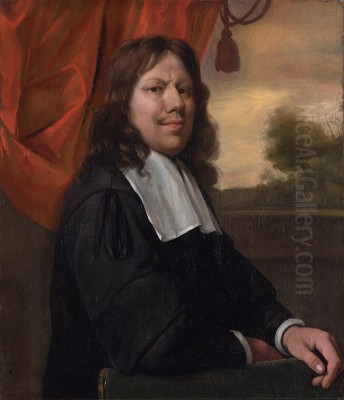
The Dutch Golden Age, spanning roughly the 17th century, was a period of extraordinary wealth, scientific discovery, and artistic flourishing in the Netherlands. While masters like Rembrandt van Rijn explored the depths of the human psyche through portraiture and historical scenes, and Johannes Vermeer captured moments of serene domestic tranquility, another giant, Jan Steen, offered a different, yet equally profound, reflection of Dutch life. Steen stands as one of the era's most prolific and beloved painters, renowned for his lively, humorous, and often chaotic depictions of everyday existence. His canvases, teeming with activity and incident, provide an unparalleled window into the homes, taverns, and celebrations of his time, blending keen observation with witty commentary and subtle moral lessons.
Jan Steen was primarily a genre painter, an artist who focused on scenes of ordinary life. Unlike the often idealized or tranquil visions of some contemporaries, Steen embraced the messy, vibrant, and sometimes unruly aspects of human behaviour. His works are characterized by dynamic compositions, a rich colour palette, and an exceptional ability to capture fleeting expressions and gestures. Through his art, Steen became a visual chronicler of his society, documenting its customs, joys, and follies with an infectious energy that continues to engage viewers centuries later. He was not merely an observer but also a storyteller, often embedding narratives and moral messages within his bustling scenes, inviting viewers to both laugh and reflect.
Early Life and Artistic Formation in Leiden
Jan Havickszoon Steen was born in Leiden around 1626. Leiden was a prominent university city and a centre of textile production, offering a stimulating environment. His family belonged to the prosperous Catholic minority in a predominantly Calvinist nation. His father, Havick Steen, was a brewer and grain merchant, suggesting a comfortable middle-class background that likely provided young Jan with a good education. Records indicate he attended the Latin School in Leiden, which would have given him a grounding in classical literature and history, themes that occasionally appear in his later work.

Like many aspiring artists of his time, Steen likely enrolled briefly at Leiden University, though his true passion lay in painting. His formal artistic training involved apprenticeships under several notable masters, shaping his diverse skillset. It is believed he studied first with Nicolaes Knupfer in Utrecht, a German painter known for small-scale historical and biblical scenes, which may account for Steen's own ventures into these genres. He is also thought to have been influenced by, or perhaps studied with, Adriaen van Ostade in Haarlem, a master of peasant genre scenes, whose depictions of tavern life and rustic interiors find echoes in Steen's work.
A crucial connection formed when Steen moved to The Hague around 1649. There, he entered the studio of the renowned landscape painter Jan van Goyen. This association was pivotal both professionally and personally. While Steen rarely focused purely on landscape, Van Goyen's influence might be seen in the atmospheric backgrounds of some works. More significantly, in 1649, Steen married Van Goyen's daughter, Margriet (Grietje), forging a lasting family tie to the artistic community. This period marked the beginning of his independent career and the development of his characteristic style.
A Peripatetic Career: Leiden, The Hague, Delft, Haarlem
Steen's professional life was marked by movement between several Dutch cities, each potentially influencing his art and reflecting the fluid nature of the 17th-century art market. Before his move to The Hague, he was already active in his native Leiden. In 1648, he was among the founding members of the Leiden Guild of Saint Luke, the professional organization for painters and other artisans. His co-founder was Gabriel Metsu, another Leiden painter who would become famous for his refined genre scenes, suggesting early collegial relationships within the city's artistic circles.
His time in The Hague (c. 1649-1654), where he worked with his father-in-law Jan van Goyen, was followed by a move to Delft (c. 1654-1657). Delft was then a major artistic centre, home to painters like Carel Fabritius (until his tragic death in the gunpowder explosion of 1654) and the young Johannes Vermeer. In Delft, Steen leased a brewery called "De Slang" (The Snake), perhaps attempting to emulate his father's trade or supplement his income from painting. However, contemporary accounts suggest he was not a particularly successful businessman, and this venture seems to have been short-lived. Financial difficulties appear to have been a recurring theme in his life.
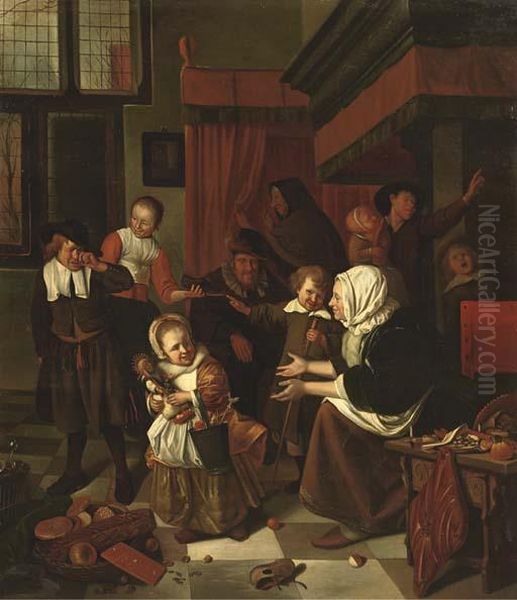
Following Delft, Steen lived briefly in Warmond, near Leiden (c. 1658-1660), before settling in Haarlem for a decade (1660-1670). Haarlem had a rich artistic tradition, famously associated with Frans Hals and Adriaen van Ostade. This period in Haarlem is considered one of Steen's most productive and artistically mature phases. He created many of his most celebrated works there, refining his complex compositions and vibrant storytelling. The artistic environment of Haarlem, known for both portraiture and lively genre scenes, likely provided fertile ground for his talents.
The death of his wife Margriet in 1669, followed by the death of his father in 1670, prompted Steen's return to Leiden. He inherited the family home and spent the remainder of his life there. He continued to paint prolifically and remained active in the local Guild of Saint Luke, serving as its dean in several years (1671-72, 1673-74). In 1672, perhaps again seeking financial stability, he received a license to open a tavern. This direct involvement in the tavern trade undoubtedly provided him with rich, firsthand material for his many depictions of inn life. In 1673, he married Maria van Egmond, the widow of a local bookseller, with whom he had another child. He died in Leiden in early 1679 and was buried in the Pieterskerk.
The Artist's Eye: Themes and Subjects
Jan Steen's primary contribution to Dutch art lies in his mastery of genre painting. He depicted a wide spectrum of 17th-century Dutch life, focusing particularly on scenes that allowed for narrative, humour, and social commentary. His settings are often domestic interiors, but far from the quiet, contemplative spaces of Vermeer or Pieter de Hooch. Steen's households are typically bustling, noisy, and frequently chaotic, filled with children, pets, and adults engaged in various forms of merriment or mischief. These scenes, while entertaining, often carry underlying moral messages, reflecting contemporary societal values and concerns.
Taverns and inns were another favourite milieu for Steen. He captured the boisterous energy of these establishments, depicting drinking, smoking, card games, music-making, and flirtations. These scenes allowed him to explore themes of temptation, excess, and the consequences of intemperate behaviour, often presented with a humorous, rather than harshly judgmental, tone. His experience as a brewer's son and later as a tavern keeper himself lent authenticity to these depictions.

Steen also painted numerous scenes related to celebrations and festivals. His famous The Feast of Saint Nicholas is a prime example, capturing the excitement and family dynamics of the traditional Dutch gift-giving holiday. Other works depict weddings, christenings, Twelfth Night celebrations, and theatrical performances (like the Rederijkers, or rhetoricians). These paintings showcase his skill in handling large groups of figures and creating a sense of communal activity and festive spirit.
Beyond these common themes, Steen explored other aspects of daily life. Schoolroom scenes offer glimpses into 17th-century education, often with a humorous take on unruly pupils and exasperated teachers. The recurring theme of "The Doctor's Visit" typically satirizes medical practice, often depicting a physician diagnosing "lovesickness" in a young woman. Steen frequently illustrated Dutch proverbs and sayings, making the moral explicit. Works like As the Old Sing, So Pipe the Young or Easy Come, Easy Go serve as visual warnings about setting bad examples or the transience of fortune.
Remarkably, Steen often included himself and his family members in his paintings. He appears in various guises – sometimes as a respectable participant, other times as a merrymaker or even a slightly foolish figure. His wife Margriet and their children frequently served as models. This practice adds a layer of intimacy and self-awareness to his work, blurring the line between observation and personal experience. It suggests a playful engagement with his own life and reputation, acknowledging the "Jan Steen household" – a Dutch phrase still used today to describe a messy, lively home – that his paintings helped to immortalize.
While renowned for genre, Steen's versatility extended to other types of painting, albeit less frequently. He produced a number of historical and biblical scenes, often choosing moments of drama or psychological tension, such as Moses and the Crown of Pharaoh or The Sacrifice of Iphigenia. He also painted mythological subjects and allegories. Portraiture was not his main focus, but notable examples exist, including engaging self-portraits like his Self-Portrait as a Lutenist, which presents him in the role of a cheerful musician. This breadth demonstrates his solid academic training and his ambition to engage with the full range of artistic subjects valued in his time.
Signature Style: Technique and Characteristics
Jan Steen developed a highly recognizable artistic style characterized by its energy, detail, colour, and narrative complexity. His technique served his thematic interests, allowing him to create scenes that are both visually engaging and rich in meaning. He was a master storyteller, using composition, gesture, and expression to guide the viewer's eye and unfold the narrative within the painting.
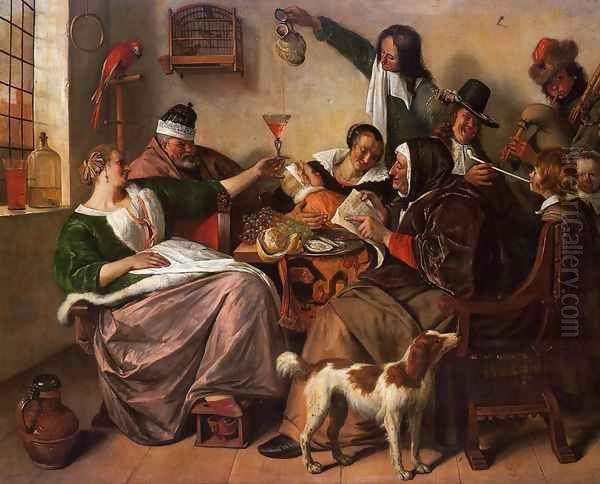
Compositionally, Steen's works are often complex and dynamic, filled with numerous figures interacting in intricate ways. While sometimes appearing chaotic, his arrangements are carefully constructed, often using diagonal lines or framing devices (like doorways or curtains) to structure the scene and create a sense of depth. He frequently employed a slightly elevated viewpoint, allowing the viewer to survey the entire scene unfolding below. This theatrical quality is a hallmark of his style, inviting the viewer to become an audience member observing the human comedy.
Steen's use of colour is typically bold and vibrant. He employed a rich palette, favouring strong reds, blues, yellows, and greens, which contribute to the lively and often festive atmosphere of his paintings. He was skilled at rendering different textures – the sheen of silk, the roughness of peasant cloth, the glint of metal, the transparency of glass. This attention to material detail adds to the realism and visual appeal of his work, grounding the sometimes-exaggerated actions in a tangible world.
Perhaps Steen's greatest strength lay in his depiction of human figures and emotions. He had an extraordinary ability to capture a wide range of expressions, from the innocent joy of children and the boisterous laughter of drinkers to the sly glances of lovers and the weary resignation of parents. His figures are rarely static; they gesture, interact, and move with convincing energy. Children, in particular, are rendered with remarkable empathy and accuracy, shown playing, squabbling, learning, and mimicking adult behaviours, often serving as key elements in the narrative or moral message.
Light plays a crucial role in Steen's paintings. He skillfully used light and shadow (chiaroscuro) to model forms, create atmosphere, and direct attention to important parts of the composition. While not possessing the profound mystery of Rembrandt's light or the luminous clarity of Vermeer's, Steen's lighting is effective and often dramatic, enhancing the theatricality of his scenes. Light might stream through a window to illuminate a central group, or fall selectively on faces and objects to emphasize their significance.
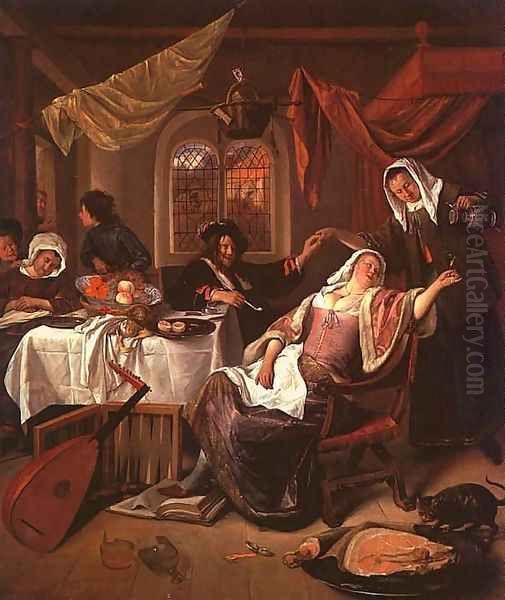
Humour is arguably the most defining characteristic of Steen's art. It ranges from gentle amusement at human foibles to outright slapstick comedy and sharp satire. He found humour in everyday situations – family squabbles, drunken antics, clumsy courtships. Yet, this humour is rarely purely frivolous. It often serves a didactic purpose, making moral lessons more palatable or highlighting the absurdity of certain behaviours. This blend of entertainment and instruction was highly appealing to his Dutch audience, who appreciated wit and moral reflection in their art. Compared to the meticulous finish and refined surfaces of the Leiden fijnschilders like Gerrit Dou or Frans van Mieris the Elder, Steen's brushwork could be looser and more painterly, prioritizing overall effect and narrative energy over microscopic detail, although he was certainly capable of fine rendering when desired.
Key Masterpieces: A Closer Look
Several paintings stand out as quintessential examples of Jan Steen's genius, embodying his characteristic themes and stylistic brilliance.
The Merry Family (c. 1668, Rijksmuseum, Amsterdam): This iconic work perfectly encapsulates the "Jan Steen household." It depicts a lively family gathering, likely Steen's own, enjoying music and drink. Steen himself raises a glass, his wife (or perhaps second wife Maria) sings from a sheet, children play instruments or listen, and an older woman (perhaps his mother) looks on. The scene is joyous but hints at excess; a note hanging from the mantelpiece likely contains a moralizing inscription, reminding viewers of the need for moderation even amidst celebration. The composition is dynamic, the colours rich, and the expressions wonderfully captured.
The Feast of Saint Nicholas (c. 1665-1668, Rijksmuseum, Amsterdam): A masterpiece of narrative complexity and emotional range. The painting shows a family on the morning of Saint Nicholas Day (December 6th). A favoured young girl beams, her arms full of gifts, including a doll and a bucket of treats. In contrast, her older brother cries dramatically, having received only a birch rod in his shoe, punishment for misbehaviour. Other family members react variously – comforting, amused, or pointing towards the chimney where Saint Nicholas supposedly entered. The scene is a rich tapestry of domestic life, sibling rivalry, parental responses, and festive tradition, rendered with warmth and intricate detail.
The Doctor's Visit (numerous versions, e.g., c. 1663-1665, Mauritshuis, The Hague): This popular theme allowed Steen to indulge in gentle satire. Typically, a well-dressed physician gravely takes the pulse of a pale young woman reclining in bed or a chair. The diagnosis, however, is often hinted to be lovesickness rather than a physical ailment. Clues might include a nearby love letter, a lute (symbol of love), or a bed warmer suggesting she is not truly feverish. The doctor often appears pompous or ineffective. Steen plays on the overlap between physical and emotional suffering, poking fun at both medical pretensions and the pangs of young love.
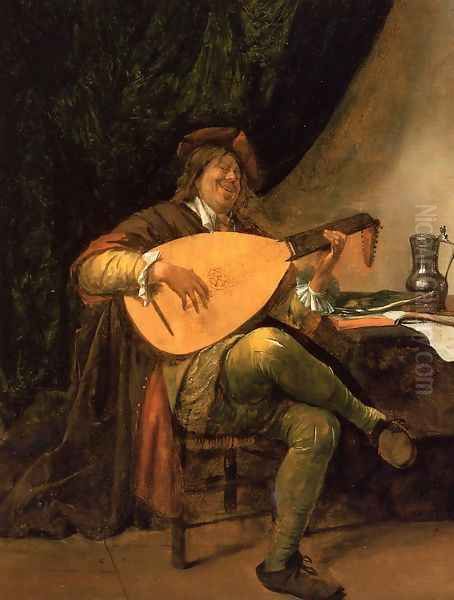
As the Old Sing, So Pipe the Young (various versions, e.g., c. 1668-1670, Mauritshuis, The Hague): This painting vividly illustrates a well-known Dutch proverb ("Soo voer gesongen, soo na gepepen"). It shows adults indulging in drinking, smoking, and merrymaking, while the children around them eagerly imitate their behaviour – a small boy is offered wine, another tries a pipe. Steen himself often appears as the indulgent father figure. The message is clear: parents must set a good example, as children learn by imitation. The lively composition and expressive figures make the moral lesson engaging rather than preachy.
The Dissolute Household (c. 1663-1664, Apsley House, London / Metropolitan Museum of Art, New York - versions exist): Another moralizing scene, depicting the chaos that ensues when order breaks down. The mistress of the house has fallen asleep (perhaps from drink), and the household descends into disorder. Servants neglect their duties, flirting and feasting; children feed a cat pie; a dog eats from the table; playing cards litter the floor. Hanging ominously overhead is a basket containing symbols of impending misfortune (a sword, crutches, a beggar's clapper), warning of the consequences of neglecting duty and succumbing to vice. Steen masterfully orchestrates the chaos, filling the canvas with telling details.
Influences, Contemporaries, and Artistic Dialogue
Jan Steen did not work in isolation. His art developed through interaction with the styles of his teachers and contemporaries, and in turn, contributed to the broader artistic landscape of the Dutch Golden Age. His training under Nicolaes Knupfer likely instilled an interest in narrative and historical subjects, while Adriaen van Ostade's influence is evident in his depictions of peasant life and tavern interiors. The connection to Jan van Goyen grounded him in the tradition of Dutch landscape and perhaps influenced his atmospheric settings.
In Leiden, his early association with Gabriel Metsu places him within the city's active genre painting scene. While Metsu developed a more refined and elegant style, both artists shared an interest in depicting domestic life. Steen's work offers a fascinating contrast to the quiet intimacy of Vermeer and Pieter de Hooch, who were active in Delft during Steen's time there. While they focused on order, light, and serene moments, Steen embraced noise, activity, and social interaction. His style stands apart from the extreme refinement of the Leiden fijnschilders like Gerrit Dou and Frans van Mieris the Elder, though he shared their attention to detail when needed.
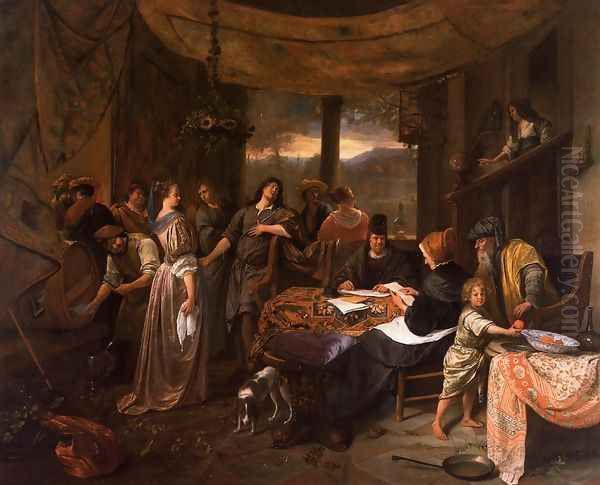
His time in Haarlem brought him into the orbit of the legacy of Frans Hals, whose lively brushwork and expressive portraiture may have encouraged Steen's own energetic handling of paint and figures. He also worked in the same city as Adriaen van Ostade and his brother Isaack van Ostade, further immersing him in the traditions of peasant genre. Steen's boisterous tavern scenes find parallels in the work of the Flemish painter Adriaen Brouwer (who worked in Holland for a time) and, on a grander scale, Jacob Jordaens in Antwerp, both known for their depictions of revelry.
Steen's relationship with the giants of the era, Rembrandt and Vermeer, is one of contrast rather than direct influence. Rembrandt's profound psychological depth and dramatic chiaroscuro represent a different artistic temperament. Vermeer's focus on light, stillness, and enigmatic beauty offers another distinct vision. Steen carved his own niche, focusing on narrative humour and social observation, becoming arguably the leading master of this type of genre painting. His prolific output and popular subject matter made him one of the most recognized and appreciated artists of his time, even if his contemporary reputation sometimes suffered from associations with the chaotic scenes he depicted. Some critics, like Arnold Houbraken writing in the early 18th century, perpetuated the myth that Steen painted as he lived, suggesting his art merely reflected a dissolute lifestyle, a view now largely dismissed by art historians who recognize the skill, intelligence, and moral purpose behind his work.
Style Evolution: From Early Steps to Mature Mastery
Throughout his career, Jan Steen's style underwent a discernible evolution, though his core interests remained relatively consistent. His earliest works, from the late 1640s and early 1650s, show the influence of his teachers. They can be somewhat tighter in execution, with influences from Knupfer in historical scenes and perhaps Van Goyen or landscape specialists like Salomon van Ruysdael in the settings. The figures might be smaller relative to the space, and the compositions less complex than his later works.
During his time in The Hague and Delft (roughly 1649-1657), Steen began to focus more intently on the genre scenes that would define his career. His compositions started to become more ambitious, incorporating more figures and narrative detail. His handling of paint remained relatively careful, but the characteristic humour and observation began to emerge more strongly.
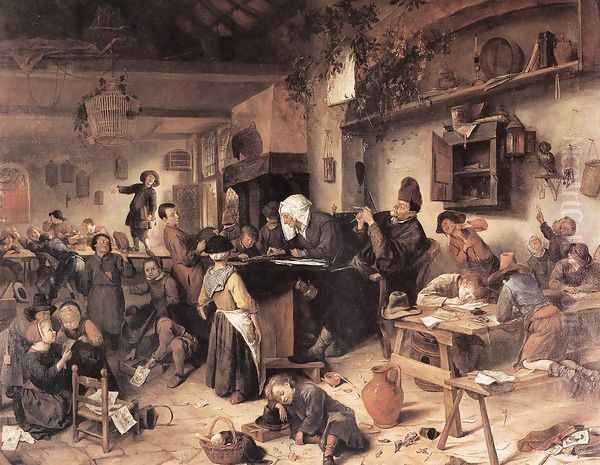
The Haarlem period (1660-1670) is widely regarded as the peak of his artistic development. His style became bolder, his colours richer, and his compositions more complex and assured. He produced many of his largest and most famous works during this decade, demonstrating complete mastery of his craft. The figures are expressive, the narratives intricate, and the blend of humour and morality perfectly balanced. His brushwork might have become slightly looser and more confident during this time, reflecting the energy of his subjects.
After his return to Leiden in 1670, Steen continued to paint prolifically until his death in 1679. His late works maintain the high quality of his Haarlem period, though some art historians detect subtle shifts. He continued to explore familiar themes but also produced significant religious and historical paintings. Some later works exhibit a certain elegance, perhaps reflecting broader trends towards a more refined aesthetic in Dutch art, occasionally hinting at the lighter Rococo style that would emerge in the following century. However, he never abandoned his fundamental interest in lively narrative and keen observation of human nature. Throughout his career, Steen remained a versatile and adaptable artist, constantly refining his ability to capture the vibrant spectacle of life.
Later Life, Death, and Enduring Legacy
Jan Steen's final decade in Leiden was marked by personal changes and continued artistic activity. The death of his first wife, Margriet, in 1669 must have been a significant blow, leaving him to care for their surviving children. His marriage to Maria van Egmond in 1673 provided new companionship. His decision to open a tavern in 1672 suggests ongoing financial pressures, possibly exacerbated by the general economic downturn following the disastrous "Rampjaar" (Disaster Year) of 1672 when Holland was invaded by France and its allies.
Despite these challenges, and perhaps struggles with alcohol as suggested by some biographers based on his frequent depictions of drinking, Steen remained a respected member of the Leiden artistic community, serving multiple terms as dean of the Guild. He continued to paint with undiminished energy and skill. He died in Leiden in February 1679, aged about 53, and was buried in the Pieterskerk. He left behind a substantial body of work, estimated at around 800 paintings, though only about 350 survive today.
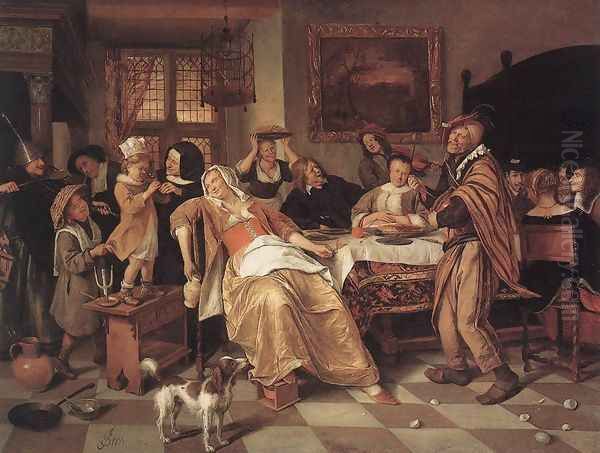
Jan Steen's legacy was immediate and lasting. His paintings were popular during his lifetime and have remained highly sought after ever since. His unique ability to blend humour, detailed observation, and moral commentary resonated with Dutch audiences and continues to fascinate viewers today. The phrase "een huishouden van Jan Steen" ("a Jan Steen household") entered the Dutch language as a common idiom for a chaotic, messy, but lively home, a testament to the enduring power of his imagery.
He influenced subsequent generations of genre painters in the Netherlands and beyond. His work enjoyed a revival of interest during the Rococo period in the 18th century, and again among 19th-century artists interested in depicting everyday life. Today, Jan Steen is firmly established as one of the three or four most important painters of the Dutch Golden Age, alongside Rembrandt, Vermeer, and perhaps Frans Hals. His paintings are prized possessions of major museums worldwide, offering an invaluable and endlessly entertaining glimpse into the society, customs, and human condition of 17th-century Holland.
Conclusion: The Human Comedy on Canvas
Jan Steen occupies a unique and vital place in the history of art. As a master storyteller and a keen observer of humanity, he captured the essence of Dutch Golden Age life with unparalleled vibrancy and wit. His canvases teem with the energy of everyday existence – the joys and squabbles of family life, the boisterous camaraderie of the tavern, the rituals of celebration, and the quiet dramas of domesticity. He approached his subjects with humour, empathy, and a subtle but persistent moral compass, inviting viewers to recognize their own follies and virtues in the scenes before them.
While contemporaries like Rembrandt delved into the soul's depths and Vermeer captured fleeting moments of luminous peace, Steen embraced the full, often messy, spectrum of human interaction. His prolific output, technical skill, narrative genius, and enduring humour make him one of the most accessible and engaging painters of his era. Through the "Jan Steen household" and countless other scenes, he left behind a rich, colourful, and profoundly human chronicle of his time, ensuring his position as a true master of the Dutch Golden Age and a timeless commentator on the human comedy.